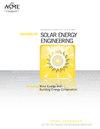An accurate explicit six-parameter solar cell model based on single-diode and its parameter extraction for seven photovoltaic technologies
IF 1.9
4区 工程技术
Q3 ENERGY & FUELS
Journal of Solar Energy Engineering-transactions of The Asme
Pub Date : 2023-10-18
DOI:10.1115/1.4063621
引用次数: 0
Abstract
Abstract The mathematical modeling of solar cells and panels is critical in many photovoltaic applications. However, the standard single-diode solar cell model, commonly selected to model these devices, is implicit and difficult to integrate into simulation software. Therefore, exact explicit solutions of this model, more suitable for computing purposes, have been proposed based on the Lambert W-function. This work introduces an explicit single-diode, easy-to-use six-parameter solar cell model. The proposed model is formulated with elementary functions. The model is developed and tested over seven photovoltaic technologies as an alternative to traditional approaches. Results of the extensive comparison of the three models (implicit, explicit Lambert W, and explicit six-parameter) show that the proposed approach is more accurate (14.81% relative improvement on average compared to the traditional methods), almost as fast as the Lambert W approach and much faster than the implicit approach. Due to its simplicity and accuracy, the proposed model will become an alternative in photovoltaic applications such as energy prediction and maximum power point tracking.基于单二极管的精确显式六参数太阳电池模型及其参数提取
摘要太阳能电池和电池板的数学建模在许多光伏应用中是至关重要的。然而,通常选择用于模拟这些器件的标准单二极管太阳能电池模型是隐式的,难以集成到仿真软件中。因此,在Lambert w函数的基础上,提出了该模型更适合计算的精确显式解。这项工作介绍了一个明确的单二极管,易于使用的六参数太阳能电池模型。该模型用初等函数表示。该模型通过七种光伏技术开发和测试,作为传统方法的替代方案。对三种模型(隐式、显式和显式六参数Lambert W)的广泛比较结果表明,所提出的方法更准确(与传统方法相比平均相对提高14.81%),几乎与Lambert W方法一样快,比隐式方法快得多。由于其简单和准确,所提出的模型将成为光伏应用的替代方案,如能量预测和最大功率点跟踪。
本文章由计算机程序翻译,如有差异,请以英文原文为准。
求助全文
约1分钟内获得全文
求助全文
来源期刊
CiteScore
5.00
自引率
26.10%
发文量
98
审稿时长
6.0 months
期刊介绍:
The Journal of Solar Energy Engineering - Including Wind Energy and Building Energy Conservation - publishes research papers that contain original work of permanent interest in all areas of solar energy and energy conservation, as well as discussions of policy and regulatory issues that affect renewable energy technologies and their implementation. Papers that do not include original work, but nonetheless present quality analysis or incremental improvements to past work may be published as Technical Briefs. Review papers are accepted but should be discussed with the Editor prior to submission. The Journal also publishes a section called Solar Scenery that features photographs or graphical displays of significant new installations or research facilities.

 求助内容:
求助内容: 应助结果提醒方式:
应助结果提醒方式:


